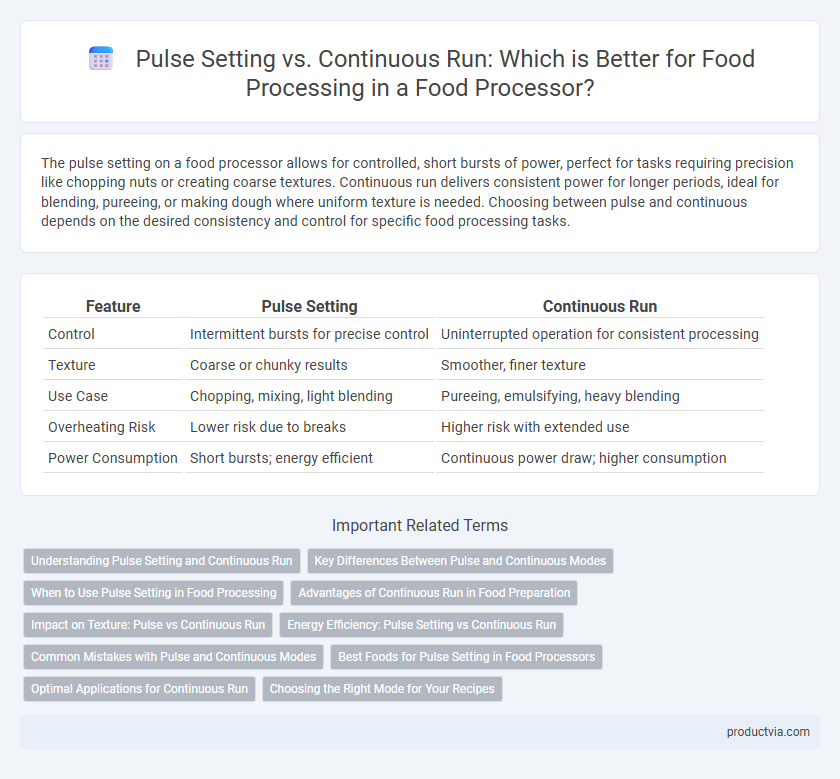The pulse setting on a food processor allows for controlled, short bursts of power, perfect for tasks requiring precision like chopping nuts or creating coarse textures. Continuous run delivers consistent power for longer periods, ideal for blending, pureeing, or making dough where uniform texture is needed. Choosing between pulse and continuous depends on the desired consistency and control for specific food processing tasks.
Table of Comparison
| Feature | Pulse Setting | Continuous Run |
|---|---|---|
| Control | Intermittent bursts for precise control | Uninterrupted operation for consistent processing |
| Texture | Coarse or chunky results | Smoother, finer texture |
| Use Case | Chopping, mixing, light blending | Pureeing, emulsifying, heavy blending |
| Overheating Risk | Lower risk due to breaks | Higher risk with extended use |
| Power Consumption | Short bursts; energy efficient | Continuous power draw; higher consumption |
Understanding Pulse Setting and Continuous Run
The Pulse setting on a food processor allows for short bursts of power, giving precise control over chopping, mixing, and blending, ideal for tasks requiring coarser textures or preventing over-processing. Continuous run mode maintains constant power, suitable for smoother purees or doughs where consistent blending is essential, but it may increase the risk of overheating the motor if used excessively. Understanding the difference ensures optimal texture control and extends the food processor's lifespan by preventing motor strain.
Key Differences Between Pulse and Continuous Modes
The pulse setting on a food processor offers short bursts of power, allowing precise control over food texture and preventing over-processing, ideal for tasks like chopping or mixing delicate ingredients. Continuous run mode provides consistent, uninterrupted operation suited for blending, pureeing, or processing large batches efficiently. Choosing between pulse and continuous modes depends on the desired outcome, with pulse ensuring finer control and continuous ensuring uniform processing.
When to Use Pulse Setting in Food Processing
The pulse setting in a food processor is ideal for tasks requiring precise control over texture, such as chopping vegetables or nuts coarsely without over-processing. It allows short bursts of power that prevent overheating and help maintain the desired consistency, making it perfect for recipes that need uneven or chunky results. Use the pulse setting when you want to avoid pureeing and need intermittent processing for customized texture.
Advantages of Continuous Run in Food Preparation
Continuous run in food processors enables consistent and even chopping, blending, or pureeing, ideal for recipes requiring uniform texture. It reduces manual intervention, saving time and effort during food preparation. Continuous operation also supports more complex tasks like kneading dough or making emulsions, enhancing overall kitchen efficiency.
Impact on Texture: Pulse vs Continuous Run
The Pulse setting on a food processor offers precise control over ingredient texture by delivering short, controlled bursts of power, preventing over-processing and maintaining chunkiness or desired consistency. Continuous run mode blends ingredients uniformly, producing smoother textures but increasing the risk of over-processing delicate components. Selecting between Pulse and Continuous run directly impacts the final texture, allowing customization from coarse to finely pureed results.
Energy Efficiency: Pulse Setting vs Continuous Run
Pulse setting in food processors enhances energy efficiency by using short, controlled bursts of power, reducing overall electricity consumption compared to continuous run modes that maintain constant motor operation. These intermittent pulses allow for precise ingredient control while preventing motor overheating and energy waste. Continuous run, although effective for uniform processing, consumes more energy and may lead to unnecessary power usage during extended operations.
Common Mistakes with Pulse and Continuous Modes
Using the pulse setting improperly often causes uneven chopping as users may fail to apply consistent bursts, leading to inconsistent texture in processed food. Continuous run misuse, such as operating for excessively long durations, can overheat the motor and result in uneven blending or pureeing. Many overlook that combining both settings appropriately enhances texture control and preserves appliance longevity.
Best Foods for Pulse Setting in Food Processors
The pulse setting in food processors excels at controlling texture for foods like nuts, herbs, and chunky salsas, allowing intermittent bursts of power for precise chopping or grinding. Continuous run is better suited for smooth purees or doughs requiring steady processing without interruption. Using the pulse setting on tough ingredients such as carrots, onions, or cheese prevents over-processing and preserves ideal consistency.
Optimal Applications for Continuous Run
The continuous run setting on a food processor is ideal for tasks requiring sustained processing, such as pureeing soups, making doughs, or blending large batches of ingredients smoothly and efficiently. This mode ensures consistent texture by maintaining an uninterrupted motor operation, which is essential for homogenizing mixtures like nut butters or emulsifying dressings. Using continuous run optimizes performance for dense or wet ingredients, preventing uneven processing and delivering professional-quality results with minimal effort.
Choosing the Right Mode for Your Recipes
The pulse setting in food processors offers precise control for chopping, mixing, or blending ingredients without over-processing, ideal for recipes requiring texture variation like salsa or coarse nut blends. Continuous run mode delivers consistent power for thorough mixing or pureeing, perfect for smooth sauces, doughs, or batters. Selecting the appropriate mode depends on the desired texture and ingredient sensitivity, ensuring optimal results for each recipe's specific requirements.
Pulse setting vs Continuous run for food processing Infographic

 productvia.com
productvia.com